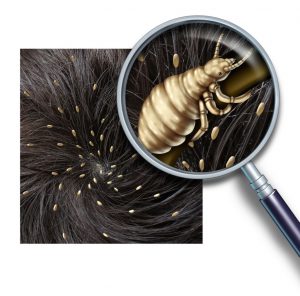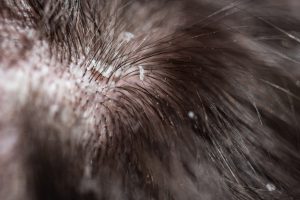If you are one of the many people who have had dandruff, you know how uncomfortable it is. Those little flakes are not only embarrassing (especially if you’re wearing black!), but dandruff also usually comes with a dry, itchy scalp. But what if your head is itchier than normal? Did you ever consider that those flakes on your head could be lice? Both lice and dandruff look similar, which is why people get easily confused, but it is important to be able to tell them apart, because the remedies for each are completely different.
What Is Lice & How Do You Get It?
Pediculus humanus capitis, more commonly known as head lice, are parasitic insects that can live on the head, eyebrows, and eyelashes. There are three different forms of lice: the eggs (also called nits), nymphs, and adult lice.The adult lice are about the size of a sesame seed and will feed on your blood. They cannot jump or fly, but instead can be transferred to someone else through sharing hats or hair brushes, hugging, or any other head-to-head contact.
What Causes Dandruff?
Dandruff, or seborrheic dermatitis, is a chronic condition that is characterized by a dry scalp with shedding skin cells that come off in the form of white flakes. It is not contagious.
Lice Vs Dandruff
Appearance
Lice look like sesame seeds, while their nits look like teardrop-shaped eggs that are white or yellow in color, giving them the appearance of flecks of skin. They are typically attached to the hair shaft close to the scalp, but not on the scalp. It is easy to confuse the eggs with dandruff, scabs, or flecks of hairspray, but they typically look more like grains of rice that are attached to a hair follicle. The eggs are very hard to remove, so you will generally need a fine-tooth comb or other type of treatment to get rid of them. Dandruff, on the other hand, causes white or sometimes yellowish flakes on your scalp, which will easily fall off when you brush your hair.
Dandruff, on the other hand, causes white or sometimes yellowish flakes on your scalp, which will easily fall off when you brush your hair.
Symptoms
Lice and dandruff both cause itching of the scalp, but lice tends to cause severe itchiness, while dandruff causes a more uncomfortable dry skin itch. Other symptoms that can differentiate lice from dandruff include:
- Tickling or crawling feeling
- Trouble sleeping because lice are most active during the night
- Red bumps or sores on the scalp, neck, and shoulders
Symptoms of dandruff include:
- Scaling on the scalp
- Pink or red skin from scratching your scalp
- White or yellowish flakes on your scalp, hair, eyebrows, or shoulders
Treatment
Both conditions can be treated successfully at home, but the treatments for lice and dandruff are very different, and it’s important to find out which issue you have so you can receive the proper treatment. To treat lice, you should:
- Use an over-the-counter medicated shampoo.
- Comb any dead and remaining live lice out of the hair using a fine-tooth nit comb.
- Wash any items that could transfer the lice to a new host, including clothing, bedding, stuffed animals, and any other things that have come in contact with your head. Wash everything with hot water and then dry them on the hottest setting.

- Vacuum all of your carpets and furniture. If something cannot be vacuumed, it should be sealed in a plastic bag for 2 weeks.
- Avoid using conditioner in your hair until it is completely free of lice and eggs.
- If the over-the-counter treatments are not effective, see your doctor to get a prescription medication.
Dandruff, on the other hand, is easier to treat. You can shampoo your hair twice a week with an anti-dandruff shampoo, keeping the shampoo in your hair for 5 to 10 minutes. If using anti-dandruff shampoo does not work, see a dermatologist to determine if the dandruff is being caused by a yeast infection or an auto-immune condition, which can require a different form of treatment/medication.
Dandruff can be embarrassing, annoying, itchy, and sometimes hard to get rid of, but it is ultimately a skin condition that can be treated fairly easily. Lice, on the other hand, are parasites that will feed on your blood and continuously lay eggs on your scalp; if not treated they will continue to lay eggs, so treating it properly, while time-consuming, is very important. Both might end up in a visit to the doctor for treatment, which can cost a lot of money, especially if you are uninsured – and the medication can be just as much as the doctor’s visit, or more. Having a good health plan can save you money by helping pay for these visits and medications – and some might even cover over-the-counter treatments for these conditions! If you would like to compare plans, and find a plan that meets your needs while saving you money, EZ can help. To get free quotes in minutes, simply enter your zip code in the bar above, or to speak to an agent, call 888-350-1890.